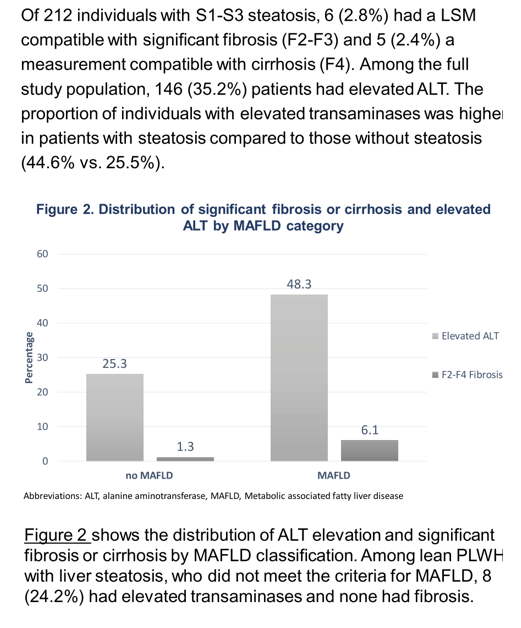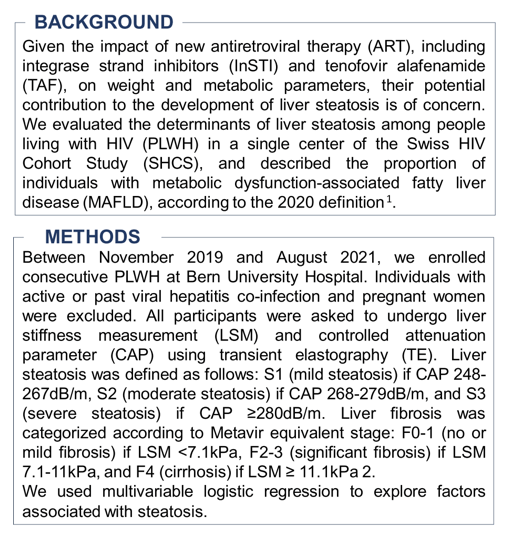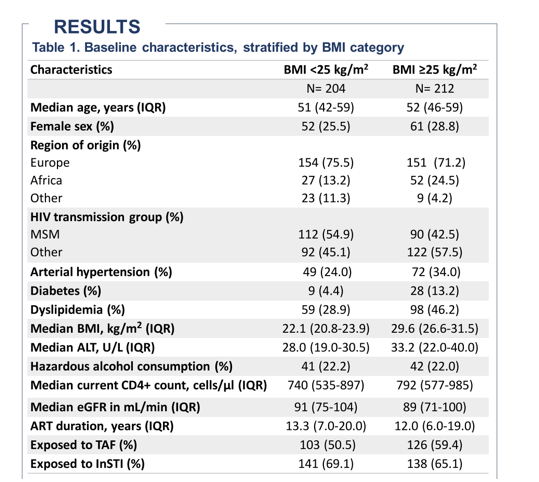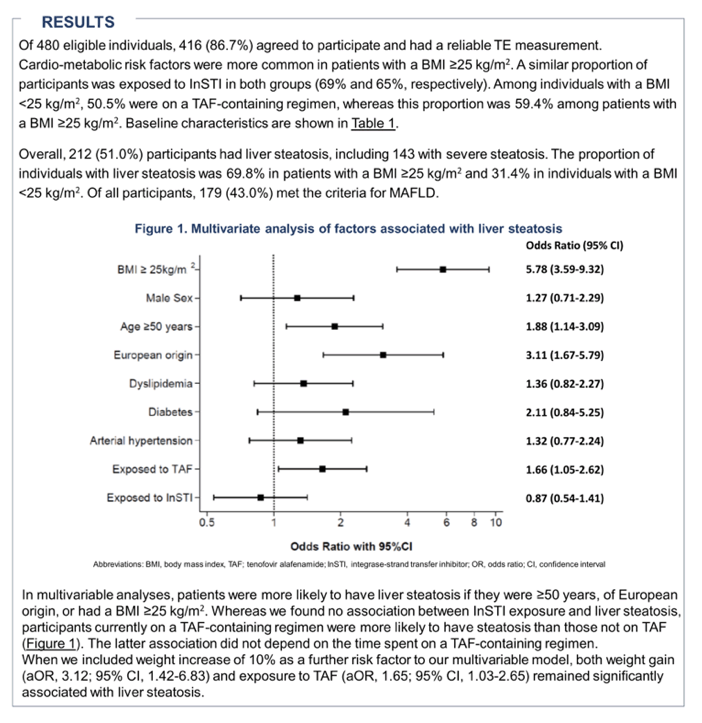 |
 |
 |
| |
DETERMINANTS OF LIVER STEATOSIS IN PEOPLE LIVING WITH HIV ON ANTIRETROVIRAL THERAPY - ALT matters
|
| |
| |
CROI 2022
Our data show a high prevalence of liver steatosis among PLWH on ART in Switzerland.
MAFLD was diagnosed in 43% of participants, including 17% with a BMI <25 kg/m2 and liver steatosis.
Overall 212, 51% had liver steatosis, including 143 with severe liver steatosis. ALT was higher in those with steatosis.
Carlotta Riebensahm1, Annalisa Berzigotti1, Bernard Surial1, Huldrych F. Günthard2, Philip Tarr3, Hansjakob Furrer1, Andri Rauch1, Gilles Wandeler1
1Bern University Hospital, University of Bern, Switzerland, Bern, Switzerland, 2University Hospital Zurich, University of Zurich, Zurich, Switzerland, 3Kantonsspital Bruderholz, University of Basel, Basel, Switzerland
program abstract
Background::
Given the impact of new antiretroviral drugs, including integrase strand inhibitors (InSTI) and tenofovir alafenamide (TAF), on weight and other metabolic parameters, their potential contribution to the development of liver steatosis is of concern. We investigated the determinants of liver steatosis in patients on antiretroviral therapy (ART) in a single site of the Swiss HIV Cohorts Study (SHCS).
Methods::
Between November 2019 and August 2021, we enrolled consecutive persons living with HIV (PLWH) at Bern University Hospital. Individuals with active or past viral hepatitis co-infection and pregnant women were excluded. Demographic, clinical and laboratory data, as well as changes in ART regimens were recorded at registration, and every six months thereafter. All participants were invited to undergo liver stiffness measurement (LSM) and controlled attenuation parameter (CAP) using transient elastography (TE). We used multivariable logistic regression to explore factors associated with steatosis.
Results::
Of 645 eligible individuals, 416 (64.5%) agreed to participate and had a reliable TE measurement. Their median age was 51 years (interquartile range [IQR] 43-59), 113 (27.2%) were female, 305 (73.3%) were Caucasian, and 212 (51.0%) overweight (BMI ≥ 25). At time of LSM, participants had been on ART for a median time of 13 (IQR 6-19) years, 279 (67.1%) had been exposed to InSTI and 229 (55.1%) to TAF.
S1-S3 liver steatosis (CAP ≥ 248dB/m) was present in 212 (51.0%) participants, of whom 139 (33.4%) had severe steatosis (S3, CAP ≥ 280dB/m).
Among individuals with S1-S3 steatosis, 11 (5.2%) had a LSM compatible with significant fibrosis or cirrhosis. In multivariable analyses, BMI ≥25kg/m2 (adjusted odds ratio, 5.78; 95% confidence interval, 3.59-9.32), age ≥50 years (1.88, 1.14-3.09), and European origin (3.11, 1.67-5.79) were strongly associated with liver steatosis. We did not find any evidence of an association between the use of InSTI and liver steatosis (0.87, 0.54-1.41), whereas participants on a TAF-containing regimen were more likely to have liver steatosis than those not exposed to TAF (1.66, 1.05-2.62). The latter association did not depend on the time spent on TAF.
Conclusion:
Our data show a high prevalence of liver steatosis among PLWH on ART in Switzerland. In addition to well-established risk factors such as age, ethnicity and obesity, the use of TAF was significantly associated with hepatic steatosis.




|
| |
|
 |
 |
|
|